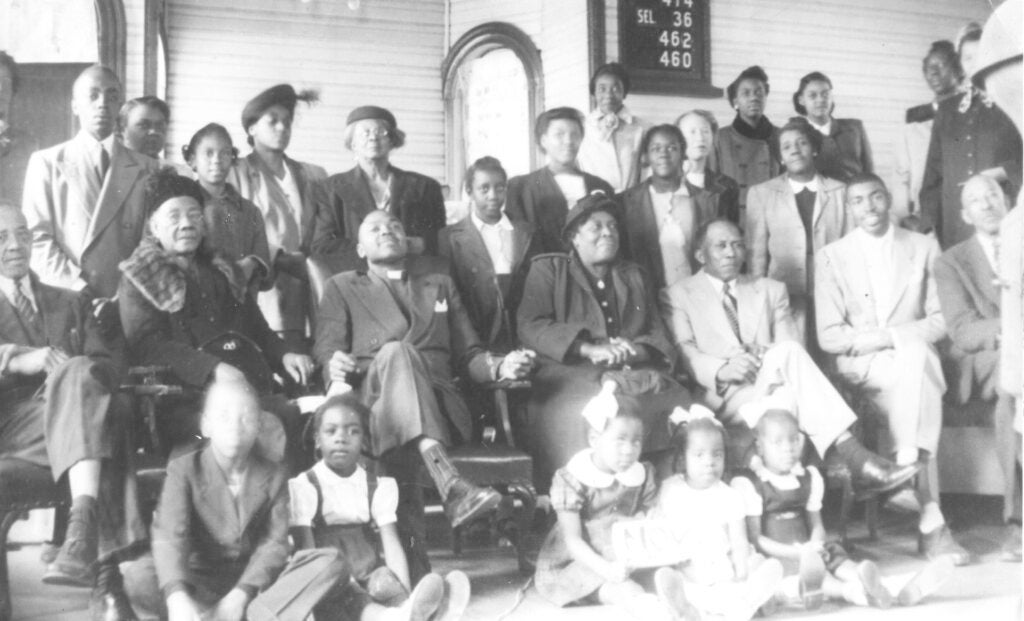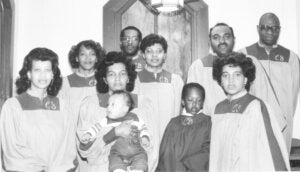History of Black religious music in Davie County and beyond
Published 11:11 am Thursday, February 15, 2024

- The choir in the 1950s at Mocksville Second Presbyterian included, from left: seated - Robert Cody, Frances Isaac, Patricia Cody, Alice Isaac; row 2 - John Smoot, Janie Foster, Rev. Robert Massey, Sylvella Williams, McKinley Steele, Baxter (BC)M Smoot, Elijah (Lash) Smoot; row 3 - Green Isaac, Barbara jean Crawford, Annie Malone, Alice Garrett, Evelyn Cain, Annie Sue Hudson, Adelaide Ellis; row 4 - Rebecca Isaac, Alma Dulin, Addie Smoot, Pecola Allison, Clara Crawford, Laurie Dulin, Margaret Smoot, Everlena Garrett and Mildred Brooks.
|
Getting your Trinity Audio player ready...
|

Members of the Cedar Grove Baptist Choir in the 1970s included: row 1 – Linda Brown, Jettie Lindsay (holding Kenneth Lewis), Justin Brown, and Betty Godwin; row 2 – Barbara Williams, Paula Lewis, John “Jerry” Goolsby; row 3 – Kelly Brown and Charles Yokely, church musician.
“The spirit will not descend without song.”
– African dictum
This article will include recent events, in two local historic African-American churches, and the impact of music in the worship services.
Cedar Grove Baptist Church is on record as the oldest African-American Church in Davie County; it was organized in 1862.
Nancy Goolsby Hairston wrote a history, which was published in the Enterprise Record in 1986. The first meetings were held at a place known as “Pine Shaw” on the Peter Hairston (Cooleemee) Plantation.
Afterwards, meetings were held at a brush arbor before an acre, which they called Cedar Grove, was purchased. The first church and the current church were located on what became Cedar Grove Church Road.
Mocksville Second Presbyterian Church was organized in 1867; the enslaved people, singing in the galleries, had made up 40 percent of the worshippers at First Presbyterian.
According to information in the Songs of Zion Hymnbook (Abingdon Press), Blacks sang the same music- i.e., hymns, psalms, songs of praise and devotion to God and His grace and mercy – as they worshiped with the Whites in their churches.
The first church of the newly emancipated was just east of the railroad, near the cemetery, between Depot Street and Lexington Road. The current church was built in 1910 on Pine Street.
For generations, residents of the nearby African-American community looked forward to the Christmas Eve Candlelight Services, the children’s speeches and the music. It became an annual tradition.
In the last 20-plus years, Stephanie Grant Redmond was in charge of the Sunday School Christmas programs where she enhanced them with her skits. The services continued to be an African American community affair and included children from other churches, too, until the COVID-19 Pandemic hit and curtailed them.
Mocksville Second uses liturgical worship and rituals for the Christian year; in 2023, Eleanor Isaac Brown wanted to continue the Christmas Eve tradition. She adapted the Lessons and Carols Service which started with the lighting of the Advent Candles. Scripture readings, followed by responses from the congregation, and hymns told the story of The Messiah’s birth.
In addition to Pastor Frederick Terry, other participants were the following youth from NJAC: Mya Smith, Angela Terry, Josiah Terry and Robert Woody. Narrators were Stephanie and Evelyn Abrams Terry; soloists were Evelyn Terry, soprano and John Quincey Steele Jr., bass-baritone.
“O Holy Night”, one of the songs sung at the service, was set to music in 1847 and was adopted by abolitionists before The Civil War. Verse 3 includes the words: “Truly He taught us to love one another; His law is love and His gospel is peace. Chains shall He break for the slave is our brother, and in His name all oppression shall cease.”
Taking the words to heart, these advocates for the liberation of the enslaved, saw “O Holy Night” as a call to action.
For his book on African American church music, James Abbington chose the title “Let Mt. Zion Rejoice!” (Judson Press); he notes three styles of worship: liturgical, traditional and contemporary. The preface includes this analysis: these songs are voices of the soul. They reflect the past of slavery, the struggle for freedom and the present with its continuing demands. They also have an ever-present hope for a future that will reflect the rulership of God over the principalities and over power.
A look at the second event: the Martin Luther King Day Service on Jan. 15, 2024 at Cedar Grove Baptist exemplified music which resonated deeply with the audience. The church choir combines traditional, gospel and contemporary music to uplift the congregation each Sunday. The soloists on Jan. 15 were Cynthia Brown West, Paula Williams Lewis, Caroline Walls Abel and Rev. Kelly Goolsby Brown. Adding their voices were Betty Brown Godwin, Linda Flint Brown, Cynthia Walls Friday, Barbara Brown Williams and John “Jerry” Goolsby.
According to Theresa Williams, a member of the church, the songs sung by the choir were a montage of contemporary and traditional gospel. Such songs as “I’m Gonna Take a Trip” and “I Come to Praise Him” were enjoyed by all. With Carlos Davis, Minister of Music, on the keyboard and his son on the drums, the selections added to the exuberance of the service.
To chronicle how we got to the present: in the PBS series, “The Black Church: This is our Story. This is our Song” hosted by Dr. Henry Louis Gates Jr., he says the early Africans adopted and adapted the White Man’s Christianity. After they learned to read, they took the King James version of the Bible and used the words for their own songs from the Exodus to Christ on the cross.
Beginning with the first arrivals in 1619, embedded deep within the bodies of these captured was the ring shout. It’s pointed out in Wikipedia, even later it became a part of some of the churches. The shout, with foot stomping, shuffling and hand clapping, happens as the body becomes ecstatically connected with the Divine; when a person is “caught up with something greater than oneself.”
In the 1700s, call and response songs and spirituals like “Swing Low Sweet Chariot” and “Steal Away to Jesus” were sung sometimes in secret, in brush arbors, in camp meetings and in praise houses. Some were slow, some were fast and some were used as signals to escape. (Library of Congress) Among others, The Fisk University Jubilee Singers (from 1871 to 1880) and Marian Anderson (from 1925 to 1965) toured America and Europe bringing spirituals to new audiences.
The Emancipation and Reconstruction, times of hope, was followed by another dark period. Looking for a better life economically and to escape oppression, according to archives.gov, the Great Migrations from 1910-1970 had approximately six million Blacks move to large cities in the North. Around the 1930s, urban gospel was born. The Library of Congress’ technical description, of gospel music, is that it’s a form of euphoric, rhythmic, spiritual music.
Rev. C.L. Franklin (active in the ministry from 1931-1979) and his then 14-year-old daughter Aretha, became famous promoters of this style. While Negro spirituals started with a cappella singers, the Hammond organ, piano and/or guitar was used to accompany gospel music. From the church, these sounds reached the masses via 78rpm vinyl records called Race Records. (history.com) Shirley Caesar called them songs of joy that help you “get over”. Gates called them a tension between sacred and secular music.
To show continuation, “O Happy Day, When Jesus Washed my Sins Away” was first sung as a hymn, written by an English minister in the 1700s. As contemporary gospel music, it was made popular in 1968 by The Edwin Hawkins Singers. These crossover pop singers were just the beginning of a new generation, grounded in church music, to have Billboard hits and go on to win Grammys in different genres. (grammy.com)
Any narrative on Black religious music is incomplete without including the role it played in the civil rights movement of the 50s and 60s.
The Freedom Singers, and later, Mahalia Jackson, raised money for the cause with their singing. Words of gospel songs and hymns were changed. The reworded songs were so powerful they kept participants (marchers) buoyed up enough to face tear gas, fire hoses, police dogs, and bully clubs with courage. “We Shall Overcome” is best known, and used in movements to fight oppression, here and in other countries across the globe.
“Lift Every Voice and Sing,” which was written by James Weldon Johnson and set to music by his brother Rosamond, addresses the black experience in the new world. It also uses the image of the Israelites’ exodus from slavery to freedom (Wikipedia.org). As with other music in this article, this hymn is a prayer of Thanksgiving to God and for His intervention. “… Sing a song full of the faith that the dark past has taught us; Sing a song full of the hope that the present has brought us; Facing the rising sun of our new day begun; Let us march on till victory is won.”
Similarly, in the liturgical year, churches have been on a journey from “O Holy Night” and a thrill of hope (Luke 2:7) moving towards Jesus’ victory over death. (Luke 25:45-53) “Free at Last! Free at Last! Thank God A’ mighty, free at Last!”
This article was written for the Enterprise Record and The Heritage Alliance Project (HAP) by Alice Garrett Brown and Jettie Theresa Williams, a descendent of the Cooleemee and Clement plantations.



